Numerical Simulation and Structural Optimization of Swirl Flow Micro-Nano Bubble Generator
Abstract
:1. Introduction
2. Materials and Methods
2.1. Geometrical Model
2.2. Multiphase Model and Turbulence Model
2.3. Mesh Generation
2.4. Boundary Conditions and Numerical Setting
2.5. Bubble Size Measurement
3. Results and Discussion
3.1. Effect of Central Air Intake Column on Bubble Generation
3.2. Effect of Variable Diameter Contraction Angle on Bubble Generation
3.3. Effect of Outlet Diameter on Bubble Generation
3.4. Numerical Simulation Results
3.5. Bubble Size Measurement Results
4. Conclusions
Author Contributions
Funding
Institutional Review Board Statement
Informed Consent Statement
Data Availability Statement
Conflicts of Interest
Nomenclature
| p | Gas phase | ṁpq | Mass transfer from gas phase to liquid phase |
| q | Liquid phase | Rpq | The interaction between two phases |
| ρ | Density | Fq | The external volumetric force |
| α | Volume fraction | Flift,q | The lift force |
| v | Fluid velocity | Fvm,q | The virtual mass force |
| g | Acceleration of gravity | vqp | The relative velocity between the gas phase and liquid phase |
| Stress tensor |
References
- Li, H.; Hu, L.; Song, D.; Lin, F. Characteristics of micro-nano bubbles and potential application in groundwater bioremediation. Water Environ. Res. 2014, 86, 844–851. [Google Scholar] [CrossRef] [PubMed]
- Hirofumi, O.; Tsunami, Y.; Ohnari, H.; Takako, Y. Generating mechanism and shrinking characteristic of micro bubbles. Proc. Hydraul. Eng. 2006, 50, 1345–1350. [Google Scholar]
- Li, Y.Z.; Sun, Z.N.; Gu, H.; Zhou, Y.M. Deposition characteristic of micro-nano soluble aerosol under bubble scrubbing condition. Ann. Nucl. Energy 2019, 133, 881–888. [Google Scholar] [CrossRef]
- Huang, S.; Jin, F.; Chen, D.; Xiao, Q.; Ding, Q. Study on Modification Mechanism and Performance of Waterborne Epoxy Resin Micro-Surfacing. Coatings 2023, 13, 504. [Google Scholar] [CrossRef]
- Levitsky, I.; Tavor, D.; Gitis, V. Microbubbles, oscillating flow, and mass transfer coefficients in air-water bubble columns. J. Water Process Eng. 2022, 49, 103087. [Google Scholar] [CrossRef]
- Marie, V.S.D.; Calum, C.; Constantin, C.C.; Eleanor, S. Properties, characteristics and applications of microbubbles for sonothrombolysis. Expert Opin. Drug Deliv. 2014, 11, 187–209. [Google Scholar]
- Bhatti, M.M.; Abdelsalam, S.I. Scientific Breakdown of a Ferromagnetic Nanofluid in Hemodynamics: Enhanced Therapeutic Approach. Math. Model. Nat. Phenom. 2022, 17, 44. [Google Scholar] [CrossRef]
- Abdelsalam, S.I.; Magesh, A.; Tamizharasi, P.; Zaher, A.Z. Versatile response of a Sutterby nanofluid under activation energy: Hyperthermia therapy. Int. J. Numer. Methods Heat Fluid Flow, 2023; ahead-of-print. [Google Scholar] [CrossRef]
- Abdelsalam, S.I.; Alsharif, A.M.; Abd, E.Y.; Abdellateef, A.I. Assorted kerosene-based nanofluid across a dual-zone vertical annulus with electroosmosis. Heliyon 2023, 9, e15916. [Google Scholar] [CrossRef]
- Abdelsalam, S.I.; Bhatti, M.M. Unraveling the nature of nano-diamonds and silica in a catheterized tapered artery: Highlights into hydrophilic traits. Sci. Rep. 2023, 13, 5684. [Google Scholar] [CrossRef]
- Cahyo, A.I.; Hiroshi, N.; Juro, M.; Katsuaki, O. Effect of different ultrafine bubble content in nutrient solution on lettuce (Lactuca sativa L. Cv. Frillice): Growth, superoxide radical accumulation, and total antioxidant capacity. Environ. Control Biol. 2022, 60, 195–204. [Google Scholar]
- Wang, X.; Shuai, Y.; Zhang, H.; Sun, J.; Yang, Y.; Huang, Z.; Jiang, B.; Liao, Z.; Wang, J.; Yang, Y. Bubble breakup in a swirl-venturi microbubble generator. Chem. Eng. J. 2021, 403, 126397. [Google Scholar] [CrossRef]
- Wang, X.; Shuai, Y.; Zhou, X.; Huang, Z.; Yang, Y.; Sun, J.; Zhang, H.; Wang, J.; Yang, Y. Performance comparison of swirl-venturi bubble generator and conventional venturi bubble generator. Chem. Eng. Process. -Process Intensif. 2020, 154, 108022. [Google Scholar] [CrossRef]
- Shuai, Y.; Guo, X.; Wang, H.; Huang, Z.; Yang, Y.; Sun, J.; Wang, J.; Yang, Y. Characterization of the bubble swarm trajectory in a jet bubbling reactor. AlChE J. 2019, 65, e16565. [Google Scholar] [CrossRef]
- Nyoman, S.; Destrianti, S.; Cindy, R.P.; Setyo, S.M.; Firdaus, A. Effect of size variation on microbubble mass transfer coefficient in flotation and aeration processes. Heliyon 2020, 6, e03748. [Google Scholar]
- Wu, Y.; Chen, H.; Song, X. Experimental and numerical study on the bubble dynamics and flow field of a swirl flow microbubble generator with baffle internals. Chem. Eng. Sci. 2022, 263, 118066. [Google Scholar] [CrossRef]
- Ding, G.; Chen, J.; Wang, C.; Shao, C.; Liu, M.; Cai, X.; Ji, Y. Structural design and numerical simulation of axial-swirling type micro-bubble generator. Process Eng. 2018, 18, 934–941. [Google Scholar]
- Kogawa, H.; Naoe, T.; Kyotoh, H. Development of micro-bubble generator for suppression of pressure waves in mercury target of spallation source. Nucl. Sci. Technol. 2015, 52, 1461–1469. [Google Scholar] [CrossRef]
- Pu, X. Study on Vortex Cavitation Synergistic Ozone Oxidation for Sludge Reduction; Jiangsu University: Zhenjiang, China, 2020. [Google Scholar]
- Ren, F.; Noda, N.A.; Ueda, T.; Sano, Y.; Takase, Y.; Umekage, T.; Yonezawa, Y.; Tanaka, H. CFD-PBM approach for the gas-liquid flow in a nanobubble generator with honeycomb structure. J. Dispers. Sci. Technol. 2019, 40, 306–317. [Google Scholar] [CrossRef]
- Juwana, W.; Widyatama, A.; Dinaryanto, O.; Budhijanto, W. Deendarlianto Hydrodynamic characteristics of the microbubble dissolution in liquid using orifice type microbubble generator. Chem. Eng. Res. Des. 2019, 141, 436–448. [Google Scholar] [CrossRef]
- Wu, M.; Song, H.; Liang, X.; Huang, N.; Li, X. Generation of micro-nano bubbles by self-developed swirl-type micro-nano bubble generator. Chem. Eng. Process. 2022, 181, 109136. [Google Scholar] [CrossRef]
- Lasheras, J.; Martinezbzan, C.; Montanes, J. On the breakup of an air bubble injected into a fully developed turbulent flow. I. breakup frequency. J. Fluid Mech. 2013, 401, 157–182. [Google Scholar]
- Li, X.; Su, W.; Liu, Y. Comparison of bubble velocity, size, and holdup distribution between single- and double-air inlet in jet microbubble generator. Chem. Eng. 2020, 16, e2611. [Google Scholar] [CrossRef]
- Martínez-Bazán, C.; Montane, J.C.; Lasheras, J.C. On the breakup of an air bubble injected into a fully developed turbulent flow. Part 2. Size PDF of the resulting daughter bubbles. J. Fluid Mech. 1999, 401, 183–207. [Google Scholar] [CrossRef]
- Fujiwara, A.; Takagi, S.; Matsumoto, Y. Bubble breakup phenomena in a venturi tube. Jt. Fluids Eng. Conf. 2007, 42886, 553–560. [Google Scholar]
- Yan, L.X.; Yan, J.Z.; Liu, N.D.; Fang, X.; Zhu, X.H.; Cheng, D. Simulation study and experimental verification of surface texture induced cavitation effect. IOP Conf. Ser. Mater. Sci. Eng. 2019, 504, 012038. [Google Scholar] [CrossRef]
- Zhao, L.; Sun, L.; Mo, Z.; Du, M.; Huang, J.; Bao, J. Effects of the divergent angle on bubble transportation in a rectangular Venturi channel and its performance in producing fine bubbles. Int. J. Multiph. Flow 2019, 141, 192–206. [Google Scholar] [CrossRef]
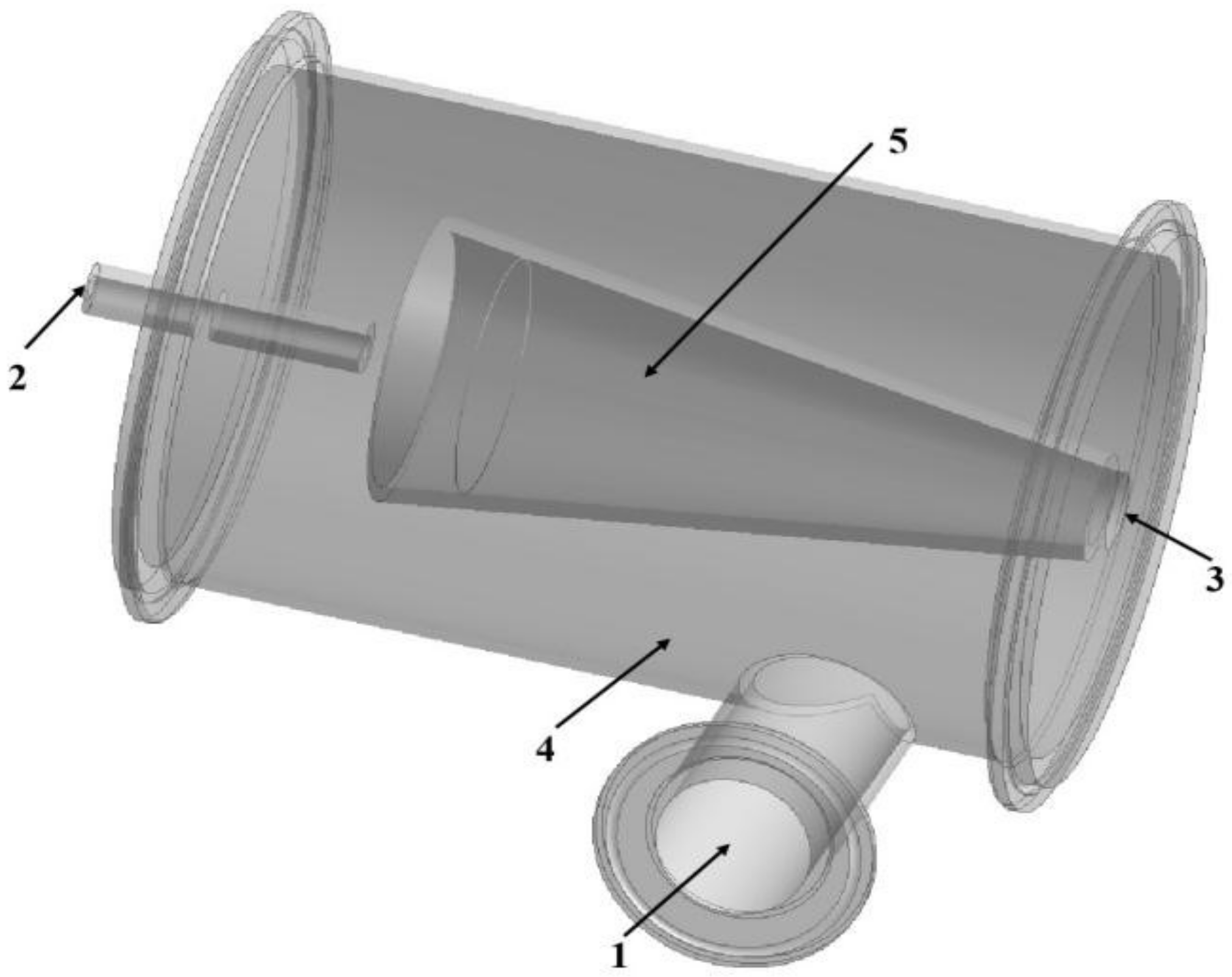
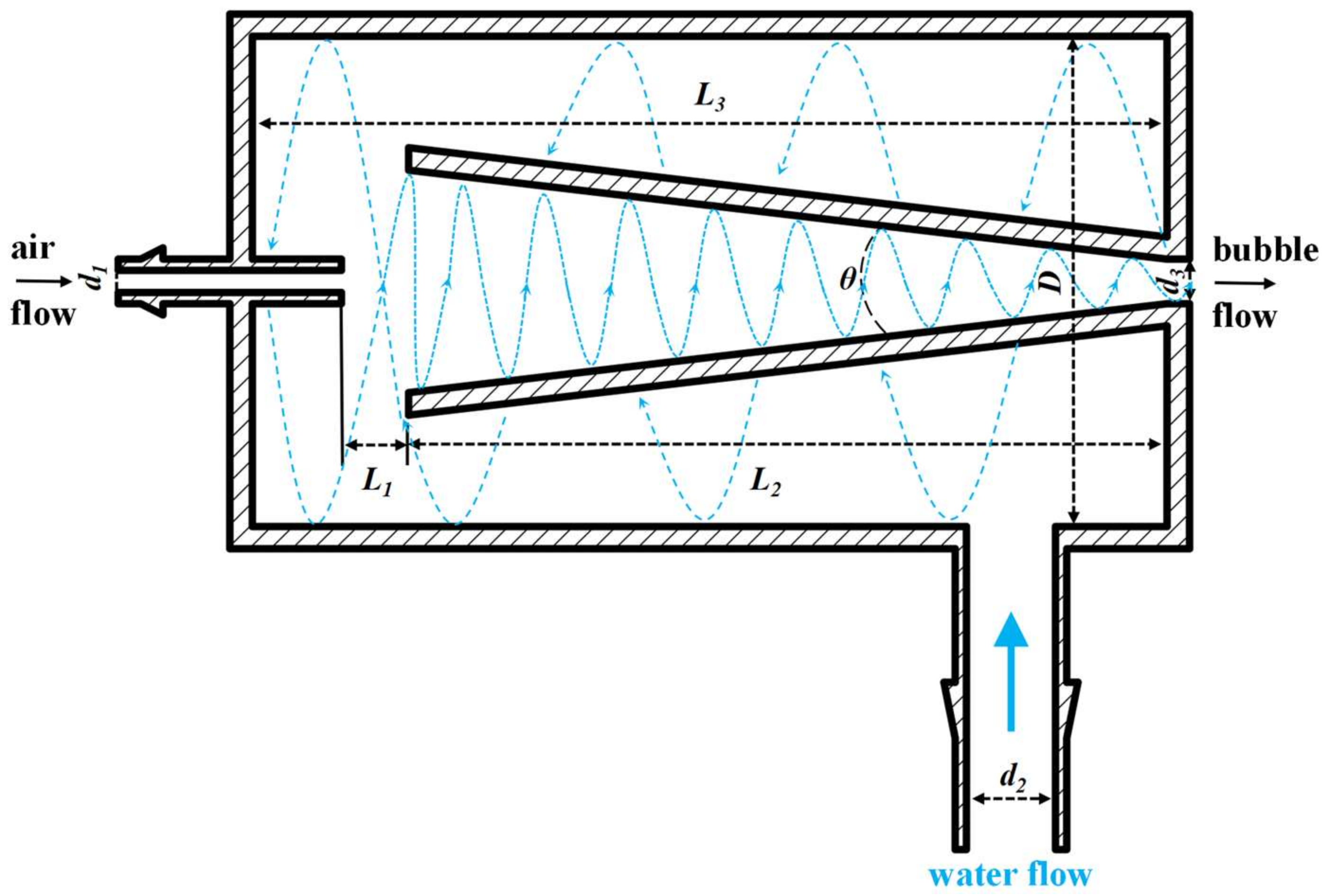
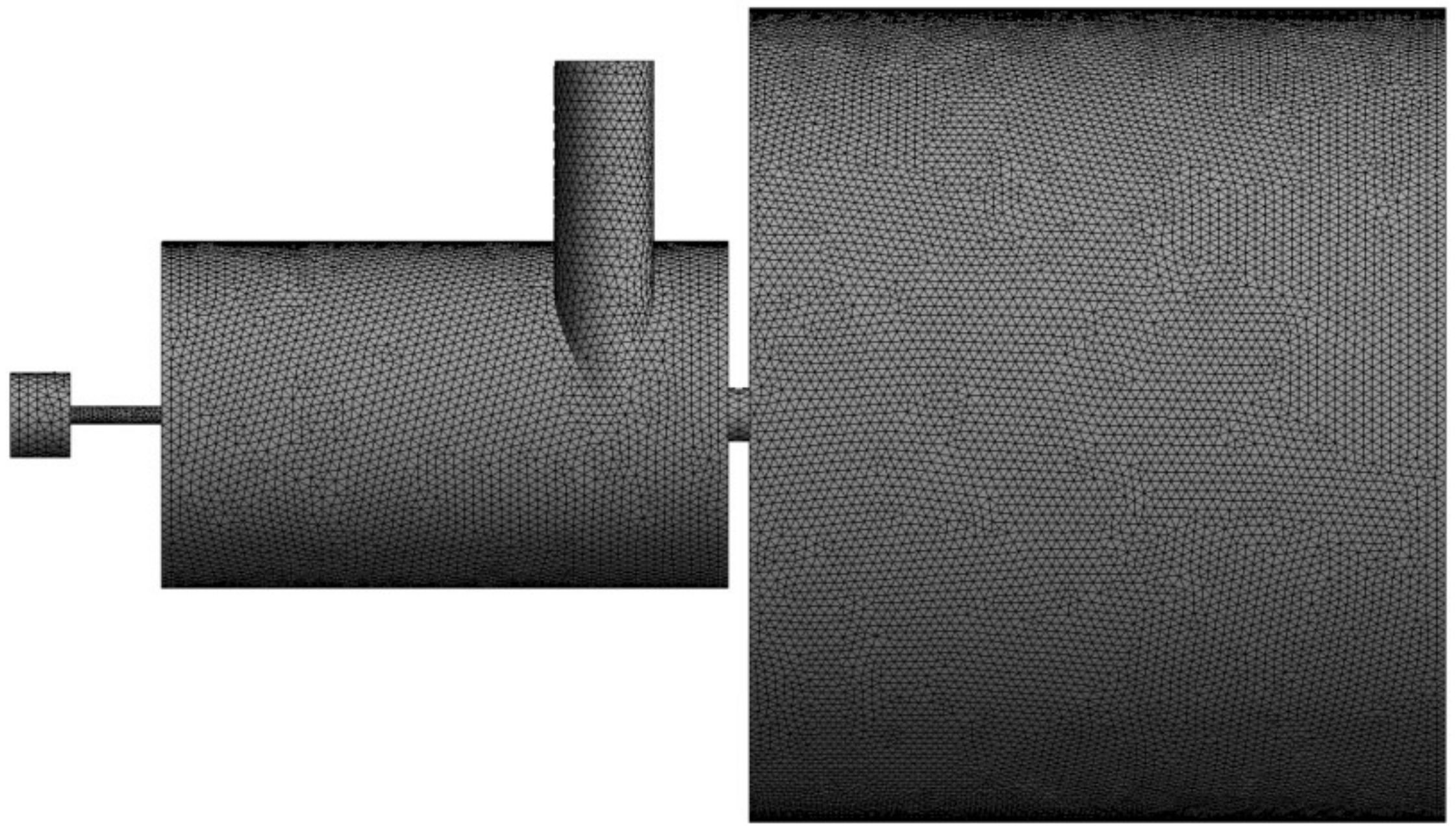

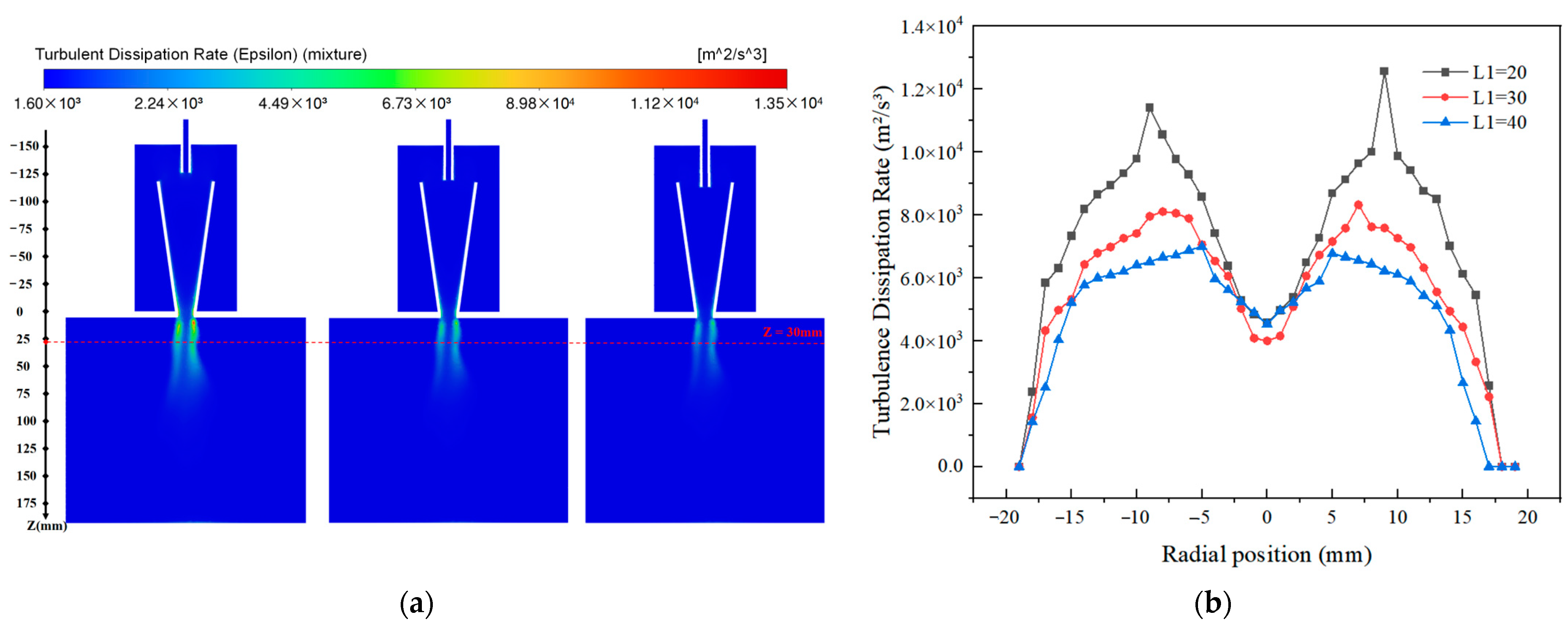
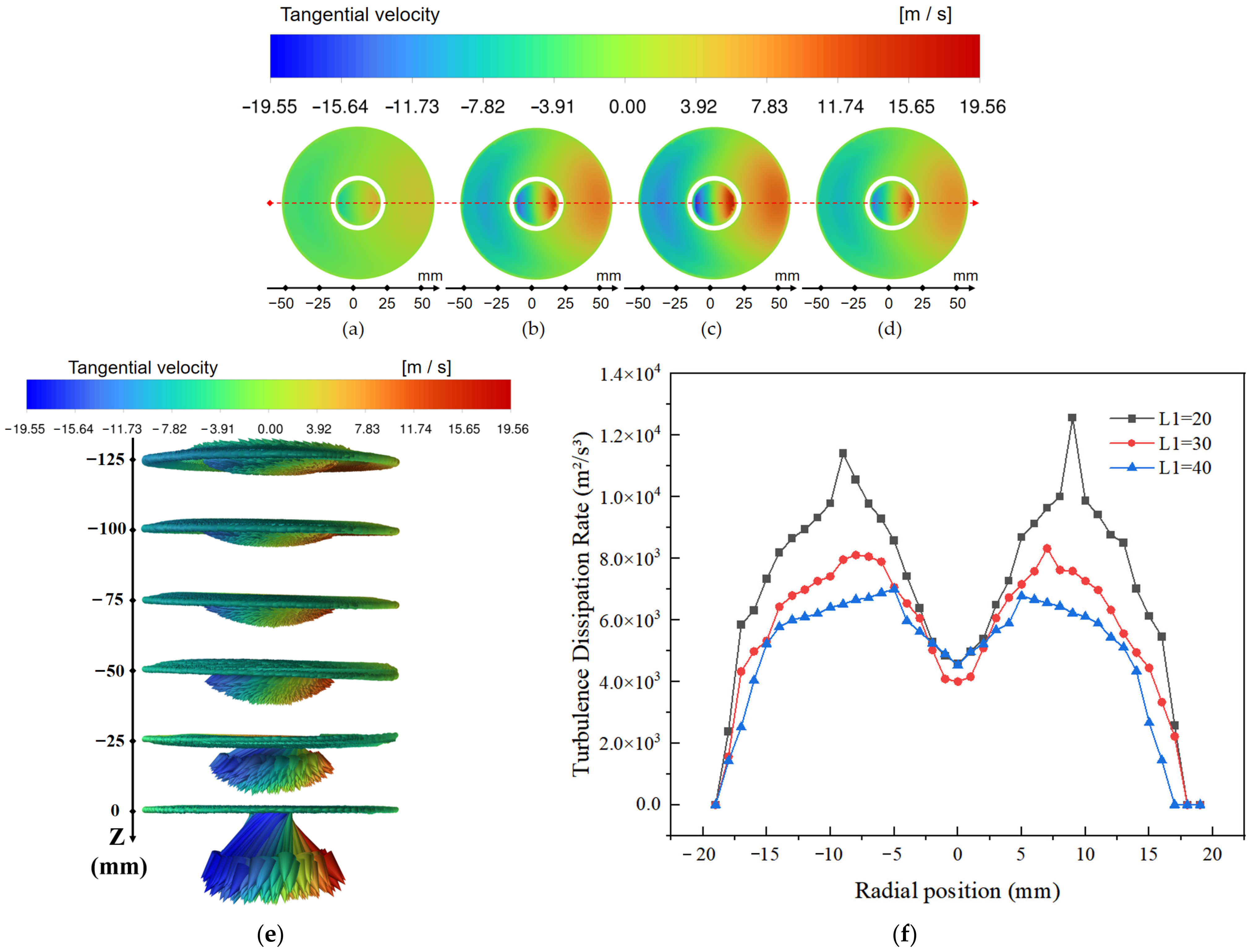
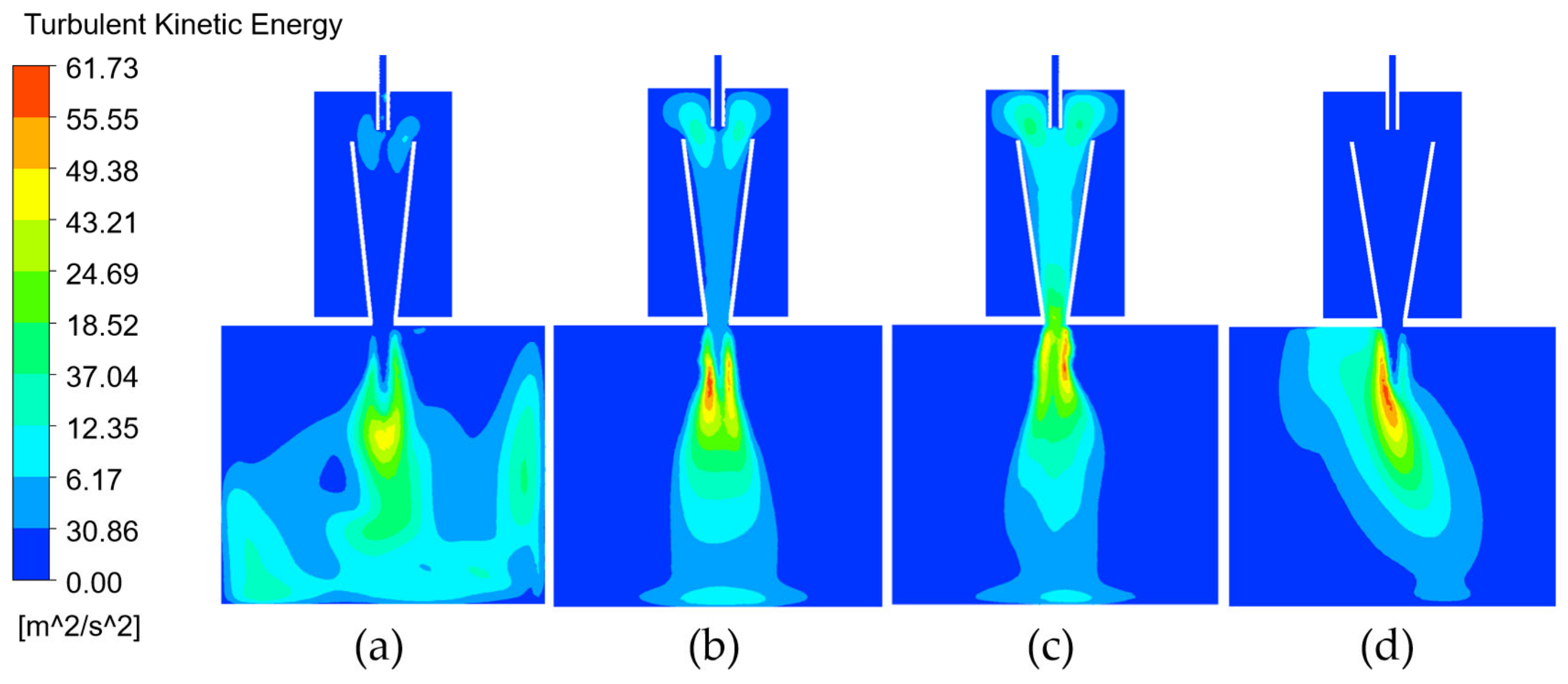

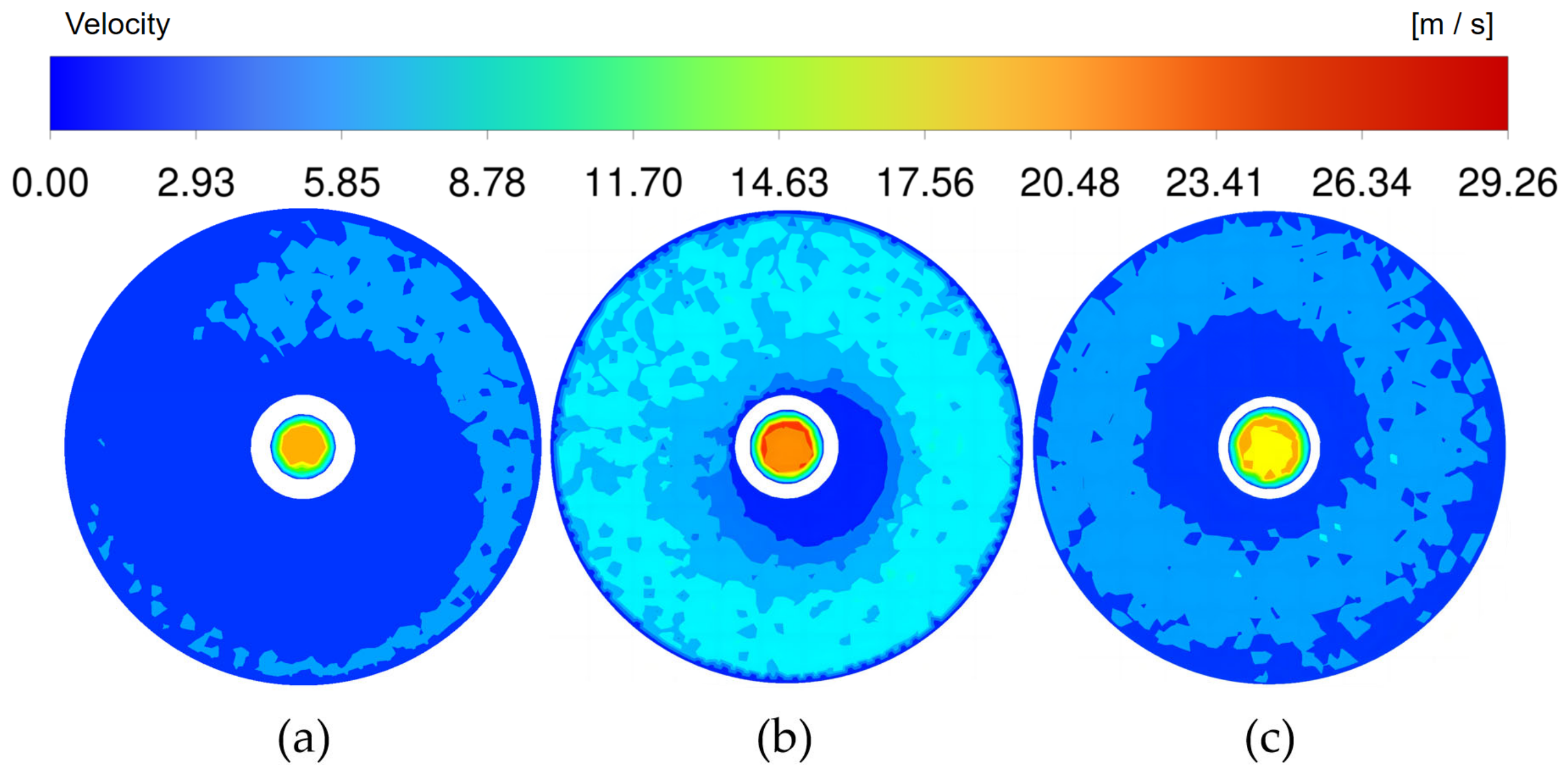

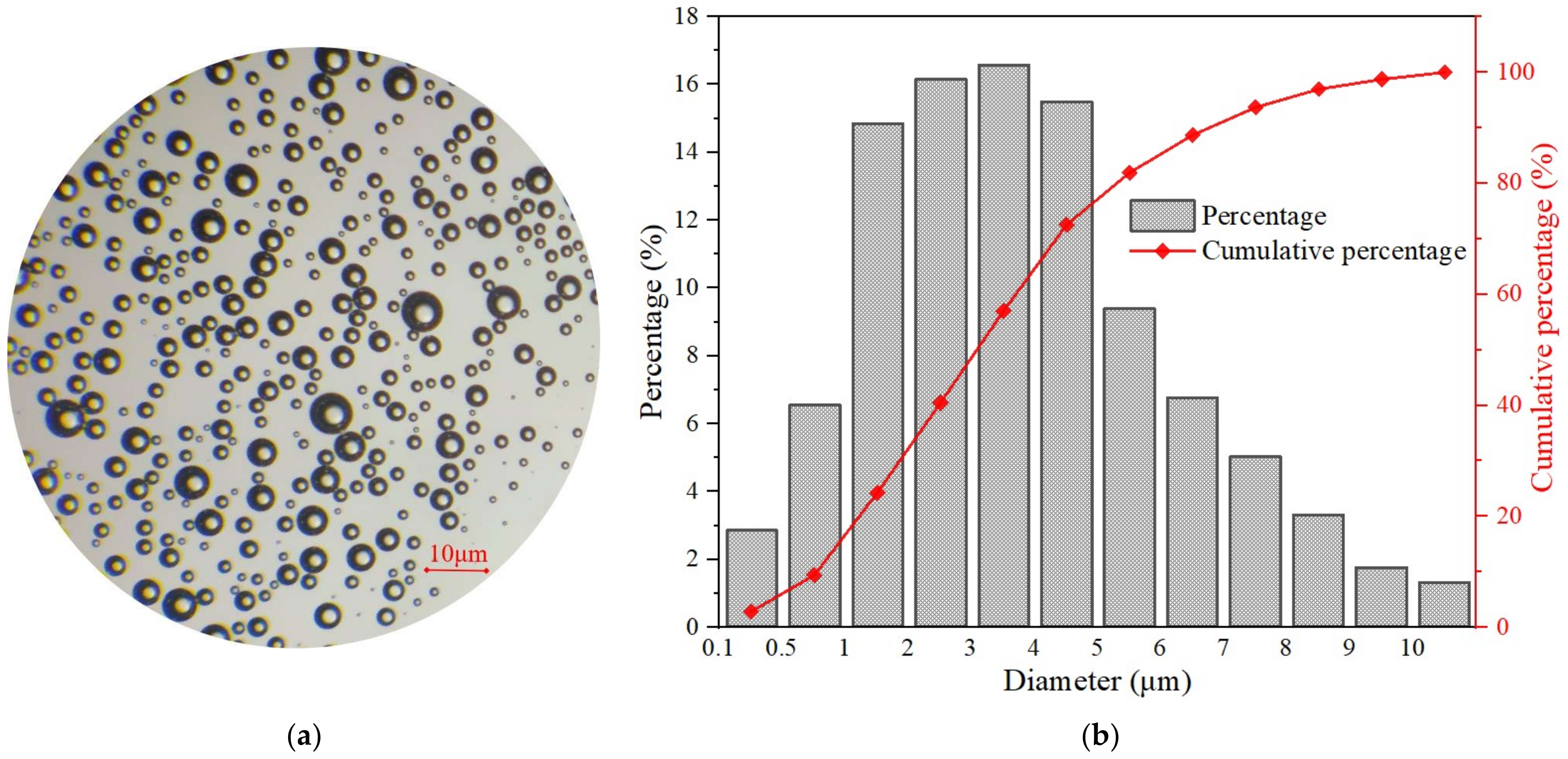
| Generator Diameter | Generator Length | Generator Angle |
|---|---|---|
| d1 = 3 mm | L1 = +10, 0, −10 mm | θ = 12, 14, 16, 18° |
| d2 = 25 mm | L2 = 125 mm | - |
| d3 = 13, 15, 17 mm | L3 = 155 mm | - |
| D = 100 mm | - | - |
| Grid Number | Outlet Velocity (m/s) | Outlet Turbulent Kinetic Energy (m2/s2) |
|---|---|---|
| 1,342,368 | 26.83 | 43.82 |
| 2,087,354 | 28.74 | 46.73 |
| 2,986,759 | 29.34 | 48.51 |
| 4,153,679 | 29.56 | 48.48 |
Disclaimer/Publisher’s Note: The statements, opinions and data contained in all publications are solely those of the individual author(s) and contributor(s) and not of MDPI and/or the editor(s). MDPI and/or the editor(s) disclaim responsibility for any injury to people or property resulting from any ideas, methods, instructions or products referred to in the content. |
© 2023 by the authors. Licensee MDPI, Basel, Switzerland. This article is an open access article distributed under the terms and conditions of the Creative Commons Attribution (CC BY) license (https://creativecommons.org/licenses/by/4.0/).
Share and Cite
Hu, X.; Zhang, B.; Wu, C.; Xu, X.; Xue, M.; Zheng, X. Numerical Simulation and Structural Optimization of Swirl Flow Micro-Nano Bubble Generator. Coatings 2023, 13, 1468. https://doi.org/10.3390/coatings13081468
Hu X, Zhang B, Wu C, Xu X, Xue M, Zheng X. Numerical Simulation and Structural Optimization of Swirl Flow Micro-Nano Bubble Generator. Coatings. 2023; 13(8):1468. https://doi.org/10.3390/coatings13081468
Chicago/Turabian StyleHu, Xinkang, Bo Zhang, Chundu Wu, Xiaohong Xu, Mingming Xue, and Xiaoyong Zheng. 2023. "Numerical Simulation and Structural Optimization of Swirl Flow Micro-Nano Bubble Generator" Coatings 13, no. 8: 1468. https://doi.org/10.3390/coatings13081468
APA StyleHu, X., Zhang, B., Wu, C., Xu, X., Xue, M., & Zheng, X. (2023). Numerical Simulation and Structural Optimization of Swirl Flow Micro-Nano Bubble Generator. Coatings, 13(8), 1468. https://doi.org/10.3390/coatings13081468






